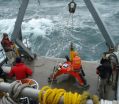The Broughton crash has become a rallying event for people concerned about the potential environmental effects of open-net salmon farming, which has become a $10 billion industry worldwide, producing nearly 1.5 million tons of fish annually.
The new study, to be published online this week in Proceedings of the National Academy of Sciences, does not determine what caused the crash, but it acquits the prime suspect: small skin parasites called sea lice.
The study's lead author is Gary Marty, a veterinary pathologist and research associate at the UC Davis School of Veterinary Medicine. An expert in fish diseases, Marty has been studying the health of pink salmon since the 1989 Exxon Valdez oil spill in Alaska.
"For anybody concerned about the effect of farm salmon on wild salmon, this is good news," Marty said. "Sea lice from fish farms have no significant effect on wild salmon population productivity."
The new study is the first to analyze 20 years of fish production data and 10 years of sea-lice counts from every salmon farm in the Broughton Archipelago and compare them against 60 years of population counts of adult pink salmon.
The study concludes that farm fish are indeed the main source of sea lice on the area's juvenile wild pink salmon, but it found no statistical correlation between lice levels on the farms and the lifetime survival of wild pink salmon populations.
Pink salmon (Oncorhynchus gorbuscha) are the most abundant wild salmon species in the Broughton Archipelago. When they are a few months old, juvenile pink salmon leave the streams where they were born. They mature at sea, then return to their native streams to spawn and die two years after their parents.
Because of their two-year lifespans, the pink salmon born in odd-numbered years are genetically different from those born in even-numbered years. In the 60-year record, both lines of pink salmon have had tremendous, unexplained population swings, even before fish farms were established in the late 1980s.
Sea lice are natural parasites of adult pink salmon. The adult louse, about the size of a small watermelon seed, attaches itself to a fish's skin and feeds on its host. Minor lice infestations are not harmful to pink salmon, but a severe infestation can weaken or kill the smallest fish (those about the size of a paperclip). On fish farms, veterinarians treat the fish with medicated feed when lice populations become too high.
The Broughton fish farms raise Atlantic salmon (Salmo salar) in net-sided pens in the water. Wild pink salmon are separated from the farm fish only by the mesh of the net enclosures. Lice freely pass from wild fish to farm fish, and vice-versa.
Record high numbers of wild pink salmon returned to spawn in rivers of the Broughton Archipelago in 2000 and 2001, but only 3 percent of that number returned in 2002, and only 12 percent in 2003.
Also, in 2001, the first examination of Broughton juvenile pink salmon found that more than 90 percent had lice. In the next two years, when the salmon numbers plummeted, the hypothesis arose that sea lice from fish farms were to blame.
Calls went up for the farms to move the fish from open-net pens to closed containers. And government regulators ordered farmers to use stricter anti-lice treatments.
In the new study, Marty and his colleagues were able to see, year by year, how many lice were on the farms when the young pink salmon went to sea, and how many of those salmon returned to spawn. The results were surprising.
"The salmon that returned in such low numbers in 2002 were exposed as juveniles to fewer sea lice than were the salmon that returned in record high numbers in 2001," Marty said. "Sea lice from farm fish could not have caused the 2002 wild salmon population crash."
Marty's co-authors are Sonja Saksida, director of the British Columbia Centre for Aquatic Health Sciences in Campbell River, and Terrance Quinn, professor of fish population dynamics at the Juneau Center of the School of Fisheries and Ocean Sciences at the University of Alaska Fairbanks. Quinn is a world authority on mathematical modeling of fish populations. Saksida is a veterinarian and the first researcher given access to confidential records from all the Broughton aquaculture companies.
Marty is also the fish pathologist for the British Columbia Ministry of Agriculture and an affiliate faculty member of the University of Alaska School of Fisheries and Ocean Sciences.
Marty said that even though the trio used much of the same fish and lice data used in previous studies, they reached a different conclusion for two reasons: First, the fish farmers gave Saksida their records, and second, the old and new data were analyzed using methods common in veterinary medical science that were not used in many of the previous studies.
"The major lesson of this study is that we cannot settle for simple explanations for wild-animal population declines. There are very complex interactions among disease, environment and animal population health. Sustainability studies must engage all the science specialties to pursue a better understanding of these relationships," Marty said.
INFORMATION:
None of the authors received compensation from any source for this analysis. Quinn has never worked for any fish farm company. Marty has never worked for any fish farm company in Canada; in the United States, he consulted for the industry in 2000 and 2001. Since 2004, Marty has analyzed fish-farm samples for the British Columbia provincial government, which is paid a fee for those services by the farm companies. Saksida, as part of her private veterinary practice over the past 15 years, has done contract work for all three fish farm companies that operate in the study area.
About UC Davis
For more than 100 years, UC Davis has engaged in teaching, research and public service that matter to California and transform the world. Located close to the state capital, UC Davis has more than 32,000 students, more than 2,500 faculty and more than 21,000 staff, an annual research budget that exceeds $679 million, a comprehensive health system and 13 specialized research centers. The university offers interdisciplinary graduate study and more than 100 undergraduate majors in four colleges -- Agricultural and Environmental Sciences, Biological Sciences, Engineering, and Letters and Science. It also houses six professional schools -- Education, Law, Management, Medicine, Veterinary Medicine and the Betty Irene Moore School of Nursing.
Links:
Questions and answers about the study [to be posted on Dec. 13; embargoed copies available until then from swright@ucdavis.edu]: http://faculty.vetmed.ucdavis.edu/faculty/gdmarty/default.html
Media contacts:
Sylvia Wright, UC Davis News Service, (530) 752-7704, swright@ucdavis.edu
Photos:
High-resolution photos are available of swimming farm salmon and a head shot of Gary Marty, from swright@ucdavis.edu.
END


